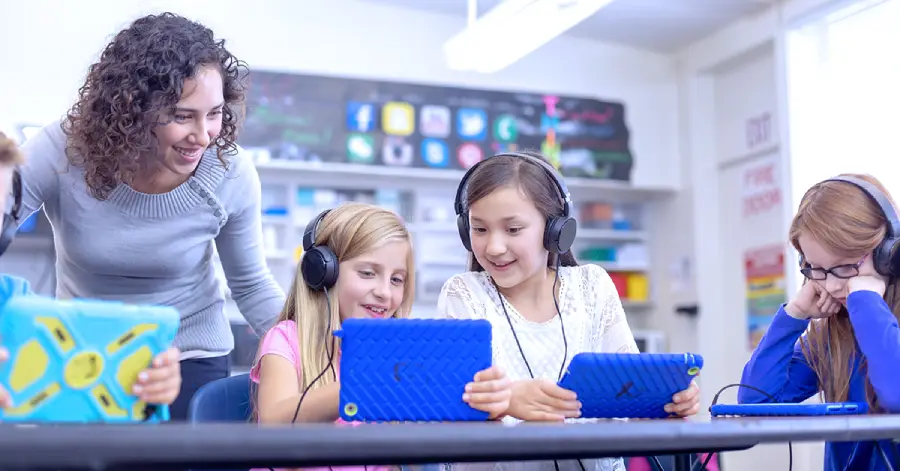12 Online Accessibility Tools For Immersive EdTech
- Published on: June 20, 2024
- |
- Updated on: May 5, 2025
- |
- Reading Time: 6 mins
- |
-
Views
- |
Understanding Web Accessibility
Importance of Accessibility in Digital Content
Common Accessibility Issues Faced by Users with Disabilities
Top 12 Online Accessibility Tools
1. User Experience Simulators
2. Accessibility Compliance Validators
3. Haptic Feedback Evaluators
4. Keyboard Accessibility Tester
5. Gesture Control Accessibility Tools
6. Speech-to-text tools
7. Color Contrast and Color Spectrum Validators
8. Screen Reader Compatibility Tools
9. Compatibility Checkers
10. Educational Content Adaptation Tools
11. Focus Management Tools
12 .Interactive Environment Customization Tools
How WCAG Provides a Framework for Accessible Web Content
Innovation in Accessibility Testing and Compliance
Usability Testing for Accessibility
Popular Accessibility Auditing and Browser Plugin Tools
Legal Requirements and Compliance for Accessible Web Content
Evaluate, Test, and Enhance Your Website’s Accessibility
Using Different Tools to Evaluate and Test Web Accessibility
Tips on Enhancing Accessibility Based on Testing Results
Incorporating Ongoing Testing into a Content Strategy
Accessibility: The Key to Inclusive XR Learning
Transform Your XR Accessibility with Magic EdTech
FAQs
Accessible immersive learning technologies in education give educators the freedom they need for knowledge transfer while catering to the needs of students with different abilities. This underscores the need for edtech to integrate online accessibility tools that respect and reflect learners’ complexities.
Understanding Web Accessibility
Immersive technologies like Virtual Reality (VR) and Augmented Reality (AR) are revolutionizing education. But without accessibility solutions, this transformation risks leaving some learners behind. By leveraging the right tools, edtech teams can develop inclusive XR solutions that meet compliance standards, enhance learning outcomes, and improve brand reputation. Below is a guide to key accessibility areas and tools every edtech leader should know.
Importance of Accessibility in Digital Content
Accessibility is critical for creating inclusive educational experiences. It ensures that learners with disabilities can engage with digital content, breaking barriers and enabling equitable access to knowledge.
Common Accessibility Issues Faced by Users with Disabilities
Many users face challenges like poor keyboard navigation, lack of screen reader compatibility, and low contrast levels. Addressing these issues is essential to eliminate barriers for users with visual, auditory, motor, or cognitive disabilities.
By integrating the right tools into XR development, edtech leaders can create inclusive, user-friendly products that enhance learning outcomes, meet compliance standards, and boost brand reputation. Below, we’ve rounded up 12 key tools to help edtech teams prioritize accessibility in XR environments.
Further, the right tools can create products, usable by every learner, maximizing positive experiences, and avoiding costly retrofits.
Top 12 Online Accessibility Tools
Below are the top 12 types of online accessibility evaluators that target prominent accessibility concerns in immersive edtech.
1. User Experience Simulators
User experience simulators are tools designed to simulate conditions based on real-time user perspectives. It can replicate user experience with different abilities to help developers understand and address accessibility barriers.
It can simulate conditions like color blindness, dyslexia, and motor disabilities in Virtual Reality (VR) environments. Similarly, simulators for visual disabilities can show developers how users with macular degeneration or tunnel vision experience VR.
Such simulators are integrated directly into development environments or are available as browser extensions to test Extended Reality (XR) applications. In this way, XR can help us better understand the experience of specific disabilities and foster greater empathy.
2. Accessibility Compliance Validators
Accessibility compliance validators are online accessibility testing tools that check XR products and applications against Web Content Accessibility Guidelines (WCAG), providing detailed reports for legal and ethical compliance. By ensuring that XR applications meet accessibility requirements, they prevent potential lawsuits and improve user inclusivity.
These validators can be directly included in the development pipeline, providing automated accessibility checks during the XR content creation. Automatic adjustments are done directly for specific errors, while others are highlighted in reports for manual upgrades.
3. Haptic Feedback Evaluators
Haptic feedback evaluators can assess whether users with visual and auditory disabilities are provided with alternate ways of receiving information and alerts. They evaluate the effectiveness of feedback through vibrations or other tactile signals. Developers can then use this feedback to fine-tune the intensity and vibration patterns. In case of minor notifications, for instance, gentle vibrations would do. On the contrary, stronger feedback is created for more critical alerts.
Developers can integrate these evaluators during the prototyping phase for iterative testing. This allows early identification and correction of potential issues. Haptic feedback evaluators can also be integrated with software or hardware like VR headsets, AR glasses, or haptic gloves to ensure effectiveness regardless of the device.
4. Keyboard Accessibility Tester
Keyboard accessibility testers check whether XR environments can be navigated and interacted with the help of keyboards. They ensure that users with motor disabilities can effectively access the XR device.
Keyboard accessibility testers collaborate with developers and UX designers early in the development, evaluating the application and testing each element to ensure it can be navigated and operated using a keyboard. They can check for issues like missing focus indicators, inaccessible interactive components, and improper tab order to enable real-time code and design adjustments.
5. Gesture Control Accessibility Tools
Gesture control accessibility tools are useful for ensuring accessibility to people with varying degrees of dexterity and motor skills. They test the responsiveness and intuitiveness of gestures such as swipes, pinches, and taps on touchscreens or motion-sensitive devices.
Developers can integrate gesture control and accessibility testing tools into their development environment or testing frameworks. These tools may come as standalone software or as plugins/extensions for existing development tools, developers using testing frameworks, PIs, and utilities for defining test cases, executing tests, and analyzing results provided by the framework.
6. Voice Recognition Software for Hands-Free Interaction
Speech-to-text tools are essential online accessibility tools to enable real-time communication. Through their natural language processing capabilities, they can convert spoken language into written text and facilitate voice-controlled navigation.
By integrating speech-to-text APIs, developers can enhance their applications with voice input capabilities, improving accessibility for users who prefer or require voice commands.
7. Visual Accessibility Tools for a Clearer Web Experience
a. Using Contrast Checkers to Ensure Visual Clarity and Readability
Contrast checkers analyze the color contrast in designs, ensuring readability for users with visual impairments. By optimizing contrast levels, developers can create visually accessible content.
b. Utilizing Color Blindness Simulators to Evaluate Design Choices
Color blindness simulators allow developers to view content as someone with color vision deficiencies would, enabling them to make informed design adjustments.
c. The Role of Magnification Software and Readability Tools in Enhancing Text Visibility
Magnification tools and readability enhancements improve the user experience for individuals with low vision, ensuring that text and visuals are clear and accessible.
8. Screen Reader Compatibility Tools
Screen reader compatibility ensures that users with visual disabilities can access the application. Screen reader tools check for proper use of HTML, ARIA roles, and other elements that enhance screen reader functionality. They can perform an accessibility audit of the web application’s markup, structure, and content.
Available as standalone software, browser extensions, or built-in features of accessibility testing platforms, developers can integrate them into the development environment or the browser developer tool.
9. Compatibility Checkers
Compatibility checkers can test whether the product is device-agnostic and can function well across operating systems and browsers. They perform feature-specific tests to verify compatibility with specific hardware components, APIs, or system configurations.
After conducting compatibility tests, these tools generate comprehensive reports detailing the evaluation results. This ensures that the user is having a consistent experience regardless of the device or platform. They can be integrated with automated testing suites, ensuring compatibility checks are performed regularly.
10. Educational Content Adaptation Tools
These tools offer features like word predictors, digital highlighters, braille formats, and text spacing adjustments for users with dyslexia and other audio-visual disabilities. It can modify content as per the diverse needs, preferences, and abilities of learners.
They use natural language processing and computer vision techniques to understand the content’s structure, context, and complexity. Further, their adaptive learning algorithms also adjust educational materials based on the learner’s profiles and objectives.
11. Focus Management Tools
Focus management tools help developers ensure that keyboard and screen reader users can navigate web content efficiently. They manage the focus state of interactive elements on a web page and apply appropriate ARIA roles to them to enhance the accessibility of screen readers. They also allow developers to customize the tab order of elements on the page for logical navigation.
Many focus management tools integrate with popular front-end frameworks and libraries to facilitate focus management in complex web applications. They provide APIs and components that developers can use to implement accessible focus management patterns within their chosen framework.
12. Interactive Environment Customization Tools
Interactive environment customization tools offer a range of features to tailor interfaces, input methods, and color schemes to improve user-friendliness. For instance, users can create 3D models in VR environments and even customize layouts depending on the setting.
They can integrate with third-party APIs and extensions to extend functionality and offer additional customization options. Developers can also create plugins, extensions, or API endpoints that extend the capabilities of the customization tool and integrate with other software systems.
How WCAG Provides a Framework for Accessible Web Content
The Web Content Accessibility Guidelines (WCAG) provide a comprehensive framework for creating accessible digital experiences. By adhering to these guidelines, organizations can ensure compliance and inclusivity.
Innovation in Accessibility Testing and Compliance
Introduction to Usability Testing for Accessibility
Usability testing focuses on how users with disabilities interact with digital products, uncovering barriers and areas for improvement.
Overview of Popular Accessibility Auditing and Browser Plugin Tools
Tools like Axe and WAVE help developers identify accessibility issues efficiently, ensuring compliance and improving user experiences.
Navigating Legal Requirements and Compliance for Accessible Web Content
Understanding and adhering to legal standards, such as Section 508 and the ADA, is crucial for delivering compliant and accessible web content.
Evaluate, Test, and Enhance Your Website’s Accessibility
Step-by-Step Guide on Using Different Tools to Evaluate and Test Web Accessibility
Evaluating web accessibility involves using tools like screen readers, contrast analyzers, and keyboard testers. These tools help identify barriers and guide remediation efforts.
Tips on Enhancing Accessibility Based on Testing Results
Once issues are identified, prioritize fixes based on user impact. Adjustments like improving contrast or fixing navigation flows can significantly enhance accessibility.
Incorporating Ongoing Testing into a Content Strategy to Maintain Accessibility
Accessibility is not a one-time task. Regular audits and updates ensure that digital content remains inclusive and meets evolving standards.
Accessibility: The Key to Inclusive XR Learning
The application of VR and AR hinges on the user’s ability and environment including gestures, spatial considerations, and surrounding sounds among others. Without a thoughtful and balanced approach that prioritizes different disabilities like visual, motor, auditory, and cognitive, the experience can be intimidating for a majority of students. Edtech leaders should take a targeted approach to immersive technology development to ensure inclusive learning.
Without accessibility, immersive technologies risk excluding users with disabilities. By prioritizing inclusive design and online accessibility tools, edtech leaders can redefine the educational experience, creating products that are both impactful and equitable.
Transform Your XR Accessibility with Magic EdTech
Magic EdTech’s MagicA11y solution ensures your AR and VR products meet rigorous accessibility standards. Our expert team provides comprehensive testing and actionable insights to help you deliver inclusive, transformative learning experiences. Let’s make education accessible for everyone.
Contact us today!
FAQs
Online accessibility tools in immersive edtech refer to software solutions designed to enhance the accessibility of educational experiences in virtual and augmented reality environments. These tools aim to cater to the diverse needs of learners, including those with disabilities, by providing features that facilitate easier access to educational content.
Online accessibility tools enhance the learning experience for students with different abilities by removing barriers to access. They ensure that educational content in immersive environments is perceivable, operable, understandable, and robust for all users, regardless of their disabilities. This inclusivity fosters equal participation and engagement in learning activities.
Yes, there are legal requirements for implementing accessibility tools in edtech products, particularly in context of educational institutions receiving federal funding. Compliance with accessibility standards such as the Web Content Accessibility Guidelines (WCAG) is often mandated to ensure equal access to educational resources for students with disabilities.
Online accessibility tools use simulators to replicate various user experiences, such as color blindness, dyslexia, and motor disabilities within immersive environments. These simulations help developers understand the challenges faced by users with different abilities and guide the design of accessible features.
Common challenges in making XR environments accessible include ensuring compatibility with assistive technologies, designing intuitive user interfaces, providing alternative modes of interaction, and addressing diverse user needs while maintaining engagement and educational efficacy.

Get In Touch
Reach out to our team with your question and our representatives will get back to you within 24 working hours.


